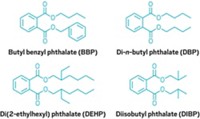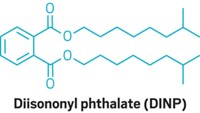Advertisement
Grab your lab coat. Let's get started
Welcome!
Welcome!
Create an account below to get 6 C&EN articles per month, receive newsletters and more - all free.
It seems this is your first time logging in online. Please enter the following information to continue.
As an ACS member you automatically get access to this site. All we need is few more details to create your reading experience.
Not you? Sign in with a different account.
Not you? Sign in with a different account.
ERROR 1
ERROR 1
ERROR 2
ERROR 2
ERROR 2
ERROR 2
ERROR 2
Password and Confirm password must match.
If you have an ACS member number, please enter it here so we can link this account to your membership. (optional)
ERROR 2
ACS values your privacy. By submitting your information, you are gaining access to C&EN and subscribing to our weekly newsletter. We use the information you provide to make your reading experience better, and we will never sell your data to third party members.
Environment
Phthalates in Toys
EU bans some phthalates in toys and child care products
by BETTE HILEMAN
October 4, 2004
| A version of this story appeared in
Volume 82, Issue 40
GOVERNMENT REGULATION
European Union nations have agreed unanimously to place permanent restrictions on some phthalates used in children’s toys and child care products. Phthalates are often used as plasticizers in polyvinyl chloride products to make them soft, rather than rigid.
New legislation would essentially ban DEHP [di(2-ethylhexyl) phthalate], DBP (di-n-butyl phthalate), and BBP (butyl benzyl phthalate) from all toys and child care articles. And it would basically ban the phthalates DINP (diisononyl phthalate), DIDP (diisodecyl phthalate), and DNOP (di-n-octyl phthalate) in toys for children under three years of age that could be placed in their mouths.
“The compromise reached today is an important step forward in helping reduce the risks to children from certain phthalates in toys and child care articles,” says Olli Rehn, EU commissioner for enterprise and information society.
In 1999, the EU placed temporary bans on these phthalates in toys and child care articles. At that time, the European Chemicals Bureau began risk assessments on each of the phthalates. The assessments found some reproductive risks from DEHP, DBP, and BBP, but essentially none from DINP.
According to the European Council for Plasticisers & Intermediates, DINP is the only phthalate still used very much in toys, and the risk assessment on DINP shows that it is safe at any level to which children could be exposed. “We are faced with a purely political decision, ignoring the scientific risk assessment,” says Tim Edgar, deputy director of ECPI.
Marian K. Stanley, manager of the Phthalate Esters Panel of the American Chemistry Council, agrees. “The panel is very concerned,” she says, “about the legal and policy implications of the EU bans, which fly in the face of the EU’s own scientific review of DINP, which found that children were not at risk from its use in toys.”
The legislation on phthalates must be approved by the European Parliament.






Join the conversation
Contact the reporter
Submit a Letter to the Editor for publication
Engage with us on Twitter